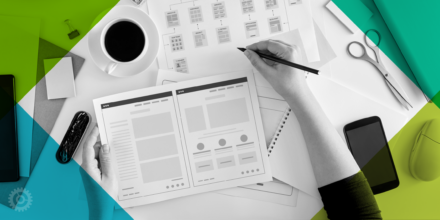
True story: A marketing manager at a professional service firm requested proposals for their firm’s website redesign and received ten bids. At the low end, the estimate was about $10K, and at the high end, the estimate was over $200K. Needless to say, she was baffled and frustrated and left feeling more confused than ever.
At Clockwork, we receive calls and emails all the time from business owners and marketers asking what the cost will be for a new or upgraded website. But asking “How much is a website?” is like asking “How much is a house?” There are so many variables: Where is the house located? How many square feet will it be? Is it one or two stories? Brick or clapboarded? Pre-fab or custom-designed? Etc.
Like any construction project, estimating a website accurately starts with a defined project scope and RFP. We have developed a Website RFP Template (available here) to help our clients receive more accurate, “apples-to-apples” proposals. Below, I outline some of the major factors that can impact a website’s bottom line:
Content
Content — text, photos, graphics, and documents — is your website’s lifeblood. Too often, content is not given the attention it deserves in the early stages of a website project. If you are happy with the content on your current site and will be porting it to the new site as-is, that’s a huge cost savings. But if your content needs a refresh or a complete rewrite, plan, and budget accordingly. Writing costs can vary from $50-$500/page for proofreading and light editing to $500-$2,000/page or more for content creation with research, interviews, and multiple rounds of review.
Design & Branding
Before diving into a website project, it is beneficial to make sure your firm has a strong, defined brand. Often, we receive RFPs that specify the new website should “differentiate the firm from our competition” or “be reflective of our firm’s style” or “appeal to existing and prospective clients.” But if you cannot describe how your firm differentiates itself, or your firm’s style, or what your clients and prospects want, need, and find appealing, how can your agency? Although an initial brand analysis can add time and cost to a website project (1-6 months, and $5,000-$30,000 or more depending on the depth of discovery), it can also help your firm’s overall marketing and business development for years to come.
Photography & Video
Stock photos can be very inexpensive, but can still add up if you need unique images on every page of your site. Custom photos and videos — of your team members, projects, case stories, etc. — can be very effective on your website, but can also add considerably to the budget. Professional photography costs can range widely for corporate shoots depending on the photographer’s experience and geographic area (rates are typically higher in major cities). In Boston or NYC, expect to pay $300-$1,000 or more for a professional portrait. Rates are generally lower when multiple team members’ portraits can be shot in the same location on the same day.
Functionality
The complexity of your site’s programming can significantly impact your budget. There are endless functionality possibilities, consider: Will your website need to tie in or communicate with any other software, such as a CRM or proposal-generating system? Will you need e-commerce capabilities? Event scheduling or calendar functions? Robust search capabilities? Project sorting features? One or more integrated blogs? Twitter feeds, CTAs, sticky navigation, easy crosslinking, gated content, etc. It’s crucial to include all requirements in your RFP, so proposals are accurate and your finished site functions per your needs.
Custom-Design Versus Templates
The vast majority of websites today are built on a CMS (Content Management System) such as WordPress, which is the most prevalent CMS on the web, by far. One of the reasons WordPress is so popular is the wide variety of pre-built templates, or “themes” (as WordPress calls them), that are available for free or for purchase. WordPress themes are like model homes: You can pick one out, make some “customizations” like paint color and countertop surfaces, then fill it with your content and you are ready to move in. But if you want to make changes to the floor plan, you are probably out of luck. You’ll need to call an architect (or a web developer, in this case). Here are the pros and cons of both:
Pros of Custom Design:
- Content Drives Design
Designing “from scratch” allows us to start by analyzing your content to assess what you want to convey to your visitors, and what your visitors want to find on your site. Intuitive site architecture is based on a clear hierarchy of content, where content drives design. - Branded Design
A website is a major part of your firm’s brand. If your firm already has established brand standards, your custom-designed website can follow those edicts. Often, a website project will be part of a rebranding initiative, and new brand standards will be based on the website design. Thus, it is crucial that the design is unique, and not readily available via a template. - Unlimited Functionality
A custom-designed site is not just about the custom “look,” it’s also about the custom functionality. How we keep visitors engaged and exploring your site is crucial to how the site is programmed. Cross-links, related content, and calls-to-action should be offered on most pages of your site, and templates rarely do this.
Pros and Cons of Themes:
- Cost Savings (kind of)
As you would expect, starting with a template can save thousands off your bottom line. However, we have seen costs add on quickly when firms find templates are not working for them and need custom programming done to adjust designs or add functionality. Much like construction projects, “fixing” poor design and construction can often end up costing more than if you build it “right,” from the start. - Time Savings (sort of)
Templates can save time since the design decisions are pre-set and the programming is done upfront. But be aware that “content population,” the process of porting text and photos into your website, is not always included as part of the estimated scope. Content population can take days or weeks, depending on the number of pages on your site. It can also add thousands of dollars to the budget. Unless you want a second full-time job, be sure to note if content population is something your web agency has line-listed in their proposal, or if they assumed you will handle it. - No Surprises (rarely)
Templates are supposed to be “what-you-see-is-what-you-get.” And the theme demo sites always look great. But, how a template looks on the demo site is not always true to how it will function. We’ve seen themes slow to a painful crawl once implemented. Your site’s load time not only affects usability but also factors into your Google ranking. More importantly, you rarely get to see the site’s administration features until you download and install the theme. Some themes are so complex and confusing, that our clients couldn’t figure out how to make basic text changes.
In closing, like most things in life, when it comes to a website you generally get what you pay for. If your firm wants a unique design that is reflective of your brand, if they need specific features and functionality that make your site easier to navigate and more engaging, then it’s wise to invest in a fully custom-designed website. If your firm is very small or just starting out, a WordPress theme or licensed solution (like Wix or Squarespace) may suffice. Rather than asking “How much is a website?” start by creating a marketing plan and determining how much you can spend on your firm’s website. Once that amount is determined, include it in your RFP so agencies can recommend how they would best allocate those dollars. Not only will you then receive more accurate bids, but you may also get some really good ideas and suggestions that will add value to your new site.
Vanessa’s article first appeared in SMPS Boston’s Outlook Blog




